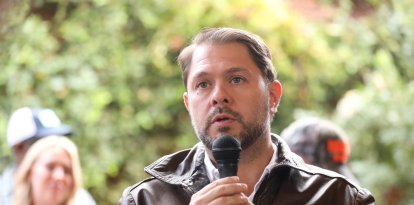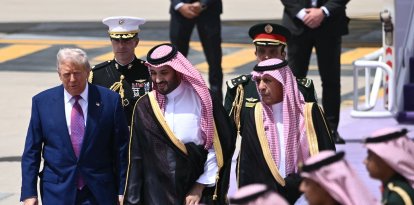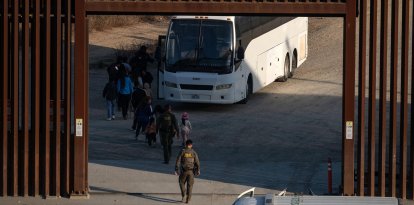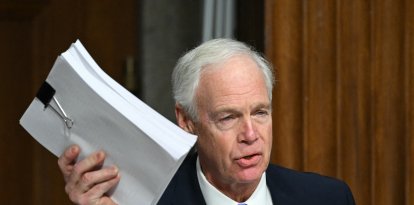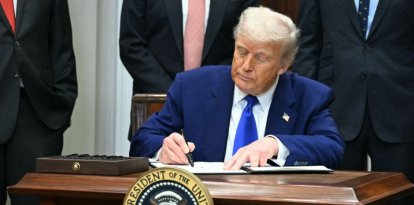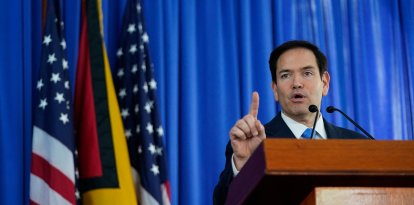Profile: Tulsi Gabbard's transformation – From lawmaker to soldier, progressive Democrat to Trump's 'chief spy' nominee
In 2013, Democrats viewed her as their rising star; by 2024, they labeled her a Moscow puppet. In 2025, Donald Trump wants her as director of national intelligence. This is the story of Tulsi Gabbard.
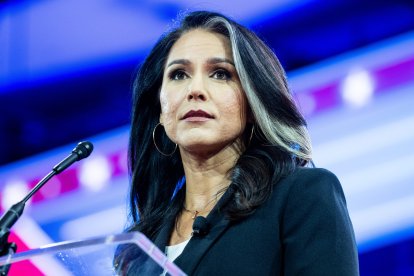
Tulsi Gabbard, Trump's nominee for intelligence director.
You can't represent a Hawaiian constituency from a barracks in Iraq - or can you?
Tulsi Gabbard Tamayo, 23, shocked everyone in 2004 with a surprising turn in her journey. Just two years earlier, she had made history as the youngest member of Hawaii's House of Representatives. Yet now, she was ready to trade the sandy beaches of the archipelago for the deserts of Iraq. Despite still serving in the House, Tulsi was determined to enlist in the Army.
Her part-time National Guard unit, which she had joined after the invasion of Iraq the previous year, was called up, and Gabbard saw no conflict between the two duties—nor the more than 8,500 miles separating Hawaii from Iraq. She consulted with House leadership, filed re-election papers (though she felt unqualified for the role), but ultimately had to make a decision about how to serve. In 2004, she chose to leave the Hawaiian legislature and was assigned to a medical unit.
This is just one of the many disruptions, controversies, and twists in the career of the former congresswoman, now chosen by Donald Trump to serve as director of national intelligence (DNI). In this role, she will oversee 18 military and civilian intelligence agencies, including the Central Intelligence Agency (CIA), the Federal Bureau of Investigation (FBI) and the National Security Agency (NSA).
She will advise and share sensitive information with the president.
Aloha, Tulsi
She was born on April 12, 1981, in Leloaloa, American Samoa. When she was two years old, her family moved to Hawaii. Her parents, Carol Porter and Mike Gabbard, chose to homeschool their five children—three boys and two girls. Their homeschooling approach included outdoor camps: "Get the tent set up, and then it was, 'Okay, let's clean up.' Then we went out and started picking up stuff on the beach," they later recalled in an interview with Hawaii News Now.
Gabbard's father was Catholic, and her mother was Hindu. While still a teenager, Tulsi, like her siblings—Bhakti, Jai, Aryan, and Vrindavan—chose to follow her mother's Hindu faith, blending it with elements of ancestral Hawaiian beliefs:
"Yes, [in Hawaii] there are the beautiful mountains, beaches, sunrises, and all of these postcard moments, but I think you [she tells her interviewer] also felt the Aloha spirit, which is really what makes this place so special. Aloha, for those who don't know what it means, is how we all start our conversations. And generally, instead of saying goodbye, we say aloha. The reason is because of what this word actually means at its deepest level. 'Alo' means to share and 'ha' represents our eternal identity as spirit, children of God."
Together with her parents, Tulsi took her first steps in politics. It started with her mother's successful campaign for the Board of Education, followed by her father's campaigns for Honolulu City Council (which he won), Congress (which he lost), and State Senate (which he won). Notably, Mike Gabbard also switched from the Republican to the Democratic Party—a move that may have influenced his daughter years later.
Tulsi Gabbard's military background also has deep genealogical roots. Both of her grandfathers served in the military, as did some of her uncles. Her father attempted to enlist during the Vietnam War but was rejected. However, her own military awakening has a specific date: September 11, 2001. The attacks on America's heartland sparked a strong desire in her to confront terrorists, which led her to enlist in the Hawaii Army National Guard. Later, in 2020, she also joined the Army Reserve.
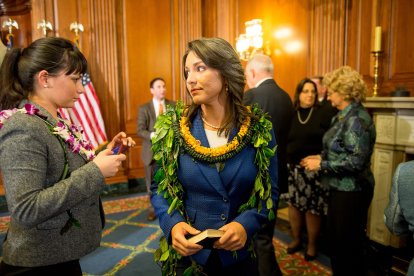
Tulsi Gabbard in Congress in 2013.
From prodigal daughter to 'Judas' of the Democratic Party
At 31, Gabbard made her way to Capitol Hill after a decisive victory in both the Democratic primary, where she secured 55% of the vote, and the general election, where she won 77% of the vote, representing Hawaii's 2nd District.
The first Hindu in Congress and one of the first female veteran congresswomen, Gabbard quickly rose as one of the Democratic Party's brightest stars, as noted by reporter John Powers in a 2013 Vogue article:
"'She’s our rock star,' says a man in an expensive suit, who hastily adds, 'Don’t quote me.' He hands me his card and I understand why: He works for a rival Democratic politician."
She further solidified her prominence within the party by being elected vice chair of the Democratic National Committee (DNC) in 2013. However, three years later, she stepped down from the role to endorse the presidential campaign of the leftist Bernie Sanders.
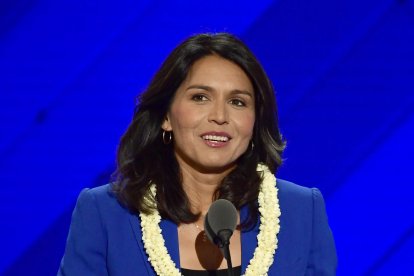
Gabbard places Bernie Sanders' name in nomination for the presidency at the 2016 Democratic National Convention.
A lot has transpired between the Gabbard who was once the Democratic Party's rising star and the one now emerging as a member of the Trump Cabinet. She clashed multiple times with the party leadership—such as when she protested the limited number of debates during the primaries—and experienced setbacks, with perhaps the most notable being her brief and unsuccessful bid for the 2020 presidential nomination.
Despite occasional clashes, Gabbard always saw herself as "the outsider," never "the party's pick," as she told The Veterans Project. Reflecting on her political journey, she said, "Looking back at my first campaign for State House, or any race I've run since—whether for City Council, Congress, or President of the United States—I've always been very independent-minded. I've never been the party's choice. I've always been viewed as the outsider."
Her break with the Democrats goes much deeper than just disagreements over the number of primary debates.
Tulsi Gabbard's transformation
"Those in control of today's Democratic Party and permanent Washington are leading us down a very dangerous path," she explained in For Love of Country: Leave the Democrat Party Behind. That path, "threatens our freedom, democracy, and ability to thrive in a peaceful, prosperous country."
In her book For Love of Country, speeches, and interviews, Gabbard accuses the Democrats of undermining democracy while pretending to protect it. "This is lunacy," she states. By that time, she had already left the Democratic Party but had not yet joined the Republicans.
Her affinity for the Republican Party, however, was clear. She described Jack Smith's insurrection case against Trump as "a nail in the coffin of democracy," criticized a war-hungry elite that she claims controls her former party, and accused Democrats of embracing extremist policies while abandoning the middle class. She also argued that Democrats champion freedom of speech only when it aligns with their interests.
"For my love of the country and specifically because of the leadership that president Trump has brought to transform the Republican Party and bring it part to the party of the people and the party of peace," she later summarized the reasons for her complete transformation on the day she announced she was joining the Republican side. Standing by her side was Donald Trump.
A viral debate
She recalls being so shy early on that during her first day of door-to-door campaigning, barely out of her twenties, she sat in her car for nearly half an hour, too nervous to get out. "I just sat there, sweating bullets," she admitted. "All I remember is it was hot—really hot. I don't even know if I had AC." She recalls wondering, "Who's going to be behind that door? What if they're not nice? What if they ask me questions I don’t know the answer to? What if I make a fool of myself? What if they slam the door in my face?"
Her skill in front of the camera and in public made her one of the most memorable figures in the 2019 Democratic presidential debates. In a pivotal moment, she confronted then-Senator Kamala Harris, positioning herself as the candidate who would reform the "rot" in the party:
"Now, Senator Harris says she's proud of her record as a prosecutor and that she'll be a prosecutor president. But I'm deeply concerned about this record. There are too many examples to cite but she put over 1,500 people in jail for marijuana violations and then laughed about it when she was asked if she ever smoked marijuana.
She blocked evidence… she blocked evidence that would have freed an innocent man from death row until the courts forced her to do so. She kept people in prison beyond their sentences to use them as cheap labor for the state of California. And she fought to keep a bail system in place that impacts poor people in the worst kind of way."
That video resurfaced during last year's presidential campaign and played a key role in motivating Trump to invite Gabbard to join the team preparing him for his own debate against Harris.
Controversies with Russia, Syria, Venezuela...
Her nomination process has reignited controversies over her ties to governments hostile to the United States. Senators from both the Democratic and Republican parties on the Senate Intelligence Committee, responsible for approving or rejecting her nomination, have expressed concern over these incidents.
In 2017, she met with Assad. The trip, which she kept secret until her return, sparked controversy at the time, resurfaced during her presidential campaign, and is now once again stirring debate. According to reports from that period, she expressed skepticism about the Syrian government's involvement in a chemical attack against its own people—an attack that U.S. intelligence, however, attributed to Assad.
In 2015, she is also reported to have argued against the removal of Syrian dictator Bashar al-Assad, warning that it would leave the country vulnerable to extremist groups. Additionally, she has been accused of spreading disinformation aligned with Russia, a key ally of the ousted Assad regime. This includes the claim that the invasion of Ukraine could have been avoided if the U.S. had paid more attention to Russia’s concerns, with her stating that Putin had "legitimate security concerns" about Ukraine potentially joining NATO.
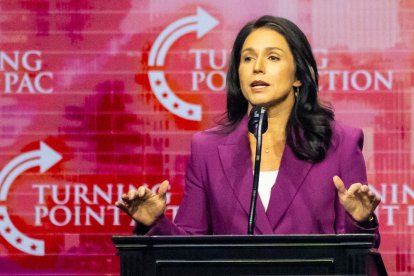
Gabbard at a conservative Turning Point Action rally.
Democrat Chris Murphy even went so far as to label her "one of the earliest parrators of Damascus and Kremlin talking points." Just weeks ago, Democratic Rep. Abigail Spanberger, a former CIA agent, said she was "appalled" by Gabbard's decisions: "Not only is she ill-prepared and unqualified, but she traffics in conspiracy theories and cozies up to dictators like Bashar-al Assad and Vladimir Putin." Even among her Republican counterparts, more cautious reservations were voiced regarding her actions and affiliations.
She has also faced criticism for her views on Section 702 of the Foreign Intelligence Surveillance Act, her support for Edward Snowden and Julian Assange, and her stance on Venezuela.
Gabbard did not remain silent regarding the criticism. In an interview with CNN, she explained her meeting with Assad, saying, "I felt that it’s important that if we profess to truly care about the Syrian people, about their suffering, then we’ve got to be able to meet with anyone that we need to if there is a possibility that we can achieve peace." Trump also came to her defense during an NBC interview: "I met with Putin. I met with President Xi of China. I met with Kim Jong-un twice. Does that mean that I can’t be president?"
In response to accusations of being servile toward Russia, the nominee rejected the claims, stating that it was a fabrication created by Hillary Clinton during the Democratic nomination contest. She likened it to a parallel version of the Russian collusion accusation against Trump during that same election cycle.
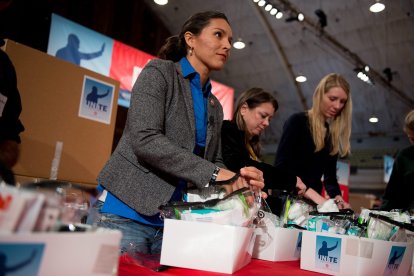
Gabbard, then a congressman, prepares service packages for members of the armed forces overseas
Lack of experience?
Another criticism from those questioning her suitability as chief spy is her lack of experience in roles similar to that of the DNI.
Beyond her formal military education—having graduated from the Alabama Military Academy's Accelerated Officer Candidate School in 2007 while also studying Business Administration—and her time on the Armed Services, Homeland Security, and Foreign Affairs committees, Gabbard emphasizes her field experience, which she claims has shaped her independent judgment.
"I came from a political background, and I understood how too many of our politicians just don't get it. They don't understand who pays the price for their decisions. We saw too many of those politicians come visit us there in Iraq, get the photo op, shake hands, pat people on the back, maybe stay for 24 hours, and then move on. And when they got back to Washington… it just made me laugh and it made me sick at the same time. I heard politicians say, 'I’ve been to a combat zone 37 times and I know what this is like.' No, you don't know anything about what it’s like. So don't even try to pretend… go and talk to the people who live this experience. Look into their eyes, look into the eyes of their families, and understand the gravity of the decisions that you're making."
RECOMMENDATION
